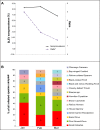Activity Patterns of St. Louis Encephalitis and West Nile Viruses in Free Ranging Birds during a Human Encephalitis Outbreak in Argentina
- PMID: 27564679
- PMCID: PMC5001705
- DOI: 10.1371/journal.pone.0161871
Activity Patterns of St. Louis Encephalitis and West Nile Viruses in Free Ranging Birds during a Human Encephalitis Outbreak in Argentina
Abstract
St. Louis encephalitis virus (SLEV) (Flavivirus) is a reemerging arbovirus in the southern cone of South America. In 2005, an outbreak of SLEV in central Argentina resulted in 47 human cases with 9 deaths. In Argentina, the ecology of SLEV is poorly understood. Because certain birds are the primary amplifiers in North America, we hypothesized that birds amplify SLEV in Argentina as well. We compared avian SLEV seroprevalence in a variety of ecosystems in and around Córdoba city from 2004 (before the epidemic) and 2005 (during the epidemic). We also explored spatial patterns to better understand the local ecology of SLEV transmission. Because West Nile virus (WNV) was also detected in Argentina in 2005, all analyses were also conducted for WNV. A total of 980 birds were sampled for detection of SLEV and WNV neutralizing antibodies. SLEV seroprevalence in birds increased 11-fold from 2004 to 2005. Our study demonstrated that a high proportion (99.3%) of local birds were susceptible to SLEV infection immediately prior to the 2005 outbreak, indicating that the vertebrate host population was primed to amplify SLEV. SLEV was found distributed in a variety of environments throughout the city of Córdoba. However, the force of viral transmission varied among sites. Fine scale differences in populations of vectors and vertebrate hosts would explain this variation. In summary, we showed that in 2005, both SLEV and to a lesser extent WNV circulated in the avian population. Eared Dove, Picui Ground-Dove and Great Kiskadee are strong candidates to amplify SLEV because of their exposure to the pathogen at the population level, and their widespread abundance. For the same reasons, Rufous Hornero may be an important maintenance host for WNV in central Argentina. Competence studies and vector feeding studies are needed to confirm these relationships.
Conflict of interest statement
The authors have declared that no competing interests exist.
Figures



Similar articles
-
Effect of Agroecosystems on Seroprevalence of St. Louis Encephalitis and West Nile Viruses in Birds, La Pampa, Argentina, 2017-2019.Emerg Infect Dis. 2022 Jul;28(7):1393-1402. doi: 10.3201/eid2807.211485. Emerg Infect Dis. 2022. PMID: 35731160 Free PMC article.
-
WNV and SLEV coinfection in avian and mosquito hosts: impact on viremia, antibody responses, and vector competence.J Virol. 2024 Oct 22;98(10):e0104124. doi: 10.1128/jvi.01041-24. Epub 2024 Sep 26. J Virol. 2024. PMID: 39324792 Free PMC article.
-
Serological detection of St. Louis encephalitis virus and West Nile virus in equines from Santa Fe, Argentina.Mem Inst Oswaldo Cruz. 2012 Jun;107(4):553-6. doi: 10.1590/s0074-02762012000400019. Mem Inst Oswaldo Cruz. 2012. PMID: 22666870
-
[West Nile virus. Prevalence and significance as a zoonotic pathogen].Bundesgesundheitsblatt Gesundheitsforschung Gesundheitsschutz. 2004 Jul;47(7):653-60. doi: 10.1007/s00103-004-0864-x. Bundesgesundheitsblatt Gesundheitsforschung Gesundheitsschutz. 2004. PMID: 15254820 Review. German.
-
West Nile virus: North American experience.Integr Zool. 2011 Sep;6(3):279-89. doi: 10.1111/j.1749-4877.2011.00251.x. Integr Zool. 2011. PMID: 21910847 Review.
Cited by
-
Evaluation of Argentinean Bird Species as Amplifying Hosts for St. Louis Encephalitis Virus (Flavivirus, Flaviviridae).Am J Trop Med Hyg. 2018 Jul;99(1):216-221. doi: 10.4269/ajtmh.17-0856. Epub 2018 May 10. Am J Trop Med Hyg. 2018. PMID: 29761767 Free PMC article.
-
Serosurvey of West Nile virus (WNV) in free-ranging raptors from Brazil.Braz J Microbiol. 2021 Mar;52(1):411-418. doi: 10.1007/s42770-020-00393-z. Epub 2020 Oct 27. Braz J Microbiol. 2021. PMID: 33108590 Free PMC article.
-
Linking Bird and Mosquito Data to Assess Spatiotemporal West Nile Virus Risk in Humans.Ecohealth. 2019 Mar;16(1):70-81. doi: 10.1007/s10393-019-01393-8. Epub 2019 Jan 23. Ecohealth. 2019. PMID: 30673905
-
Effect of Agroecosystems on Seroprevalence of St. Louis Encephalitis and West Nile Viruses in Birds, La Pampa, Argentina, 2017-2019.Emerg Infect Dis. 2022 Jul;28(7):1393-1402. doi: 10.3201/eid2807.211485. Emerg Infect Dis. 2022. PMID: 35731160 Free PMC article.
-
Emerging and Novel Viruses in Passerine Birds.Microorganisms. 2023 Sep 20;11(9):2355. doi: 10.3390/microorganisms11092355. Microorganisms. 2023. PMID: 37764199 Free PMC article. Review.
References
-
- Rocco IM, Santos CL, Bisordi I, Petrella SM, Pereira LE, Souza RP, et al. St. Louis encephalitis virus: first isolation from a human in São Paulo State, Brazil. Rev Inst Med Trop Sao Paulo. 2005;47:281–285. . - PubMed
-
- Reisen WK. Epidemiology of St. Louis encephalitis virus. Adv Virus Res. 2003;61:139–183. . - PubMed
-
- Sabattini MS, Aviles G, Monath TO. Historical, epidemiological and ecological aspects of arboviruses in Argentina: Flaviviridae, Bunyaviridae and Rhabdoviridae In: Travassos da Rosa APA, Vasconcelos PFC, Travassos da Rosa JFS, editors. An Overview of Arbovirology in Brazil and Neighbouring Countries. Belem, Instituto Evandro Chagas, 1998. pp.113–134.
MeSH terms
LinkOut - more resources
Full Text Sources
Other Literature Sources
Medical

